Services from the Imperial Porcelain Factory (LFZ)
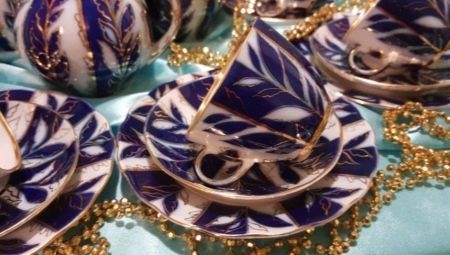
The history of the Imperial Porcelain Factory is inextricably linked with the history of the emergence of Russian porcelain. For several centuries, the company has been making exclusive and expensive items ordered by Russian emperors. It is safe to say that Russian scientists invented the porcelain recipe independently of the Europeans and Chinese.
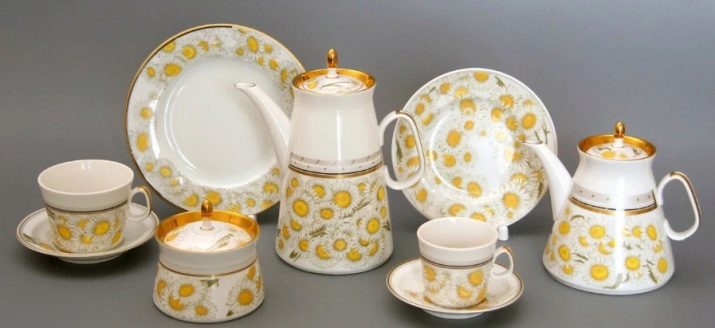
Peculiarities
The first Russian porcelain manufactory was founded in 1744 by Elizaveta Petrovna. In those days, porcelain dishes were not made in Russia, but were brought from Europe and China. The secret of making was kept in the strictest confidence. Scientist Dmitry Vinogradov developed his own composition and technology for the production of the first Russian porcelain.
For this he used clay from the Gzhel volost, quartz and alabaster from Olonetsk. The recipe included over 40 ingredients, including a unique glaze composition.

After D. Vinogradov's death, the management of the manufactory was transferred to M.V. Lomonosov. He studied the different compositions of clays, processing methods and quality after firing. It was thanks to the works of Lomonosov that porcelain "whiter than Saxon" was obtained, the optimal composition with the inclusion of feldspar was discovered.
Catherine II gave the enterprise the status of a plant and the name "Imperial". The golden age of Russian porcelain began. A collection of unique tableware, household items, figurines is now kept in the museum at the plant.There are exhibitions in Peterhof, Tsarskoe Selo and many other museums, as well as in private collections.

At the beginning of the 20th century, in honor of the 200th anniversary of the Russian Academy of Sciences, the plant was renamed into the Lomonosov Leningrad Porcelain Factory (LFZ). At this time, new industrial production technologies were developing. LFZ produces not only dishes for serving, vases, propaganda figurines, but also products for technical use.
It was during the Soviet period that the production of thin-walled porcelain, white and transparent, was established. Various shapes, hand-painted, unique style of decoration. These series are still very much appreciated in many countries of the world; collectors are ready to pay considerable sums for sets with the LFZ mark.

Description of sets of the Soviet period
After the revolution, the enterprise started producing not only tea sets, but also promotional souvenirs. Collaboration with K. Malevich, V. Kandinsky made it possible to create works that reflect the spirit of the new time. In 1925, the Soviet republic sent the best works to an international exhibition in Paris. Success and personal rewards await them. LFZ is henceforth a mark of the highest quality.
At the Brussels Exhibition in 1958, the set with a blue grid pattern wins a gold medal. Unfortunately, the author A. A. Yatskevich did not live to see this day. Anna Yatskevich survived the blockade and the idea of creating a pattern was inspired by memories of the besieged Leningrad - the windows of houses with pasted paper crosses.
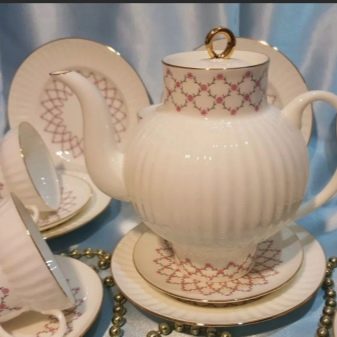
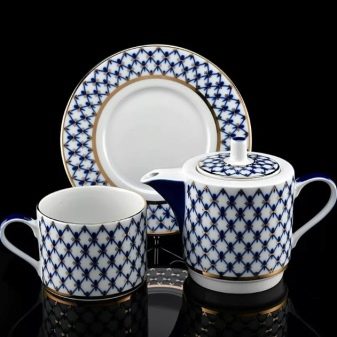
She also painted the LFZ mark, which was put on the dishes. Cobalt-mesh versions of the LFZ were produced for about 10 years, but other sets were also produced in the USSR.
"Blue Flowers"
Dishes with blue and blue flowers were produced at the factory in large quantities. In the 30s, one of the first versions was made in the design of the artist I. I. Riznich. In the 60s, a round-looking service was released with large blue inflorescences and a gilded edging (by N. Slavina).
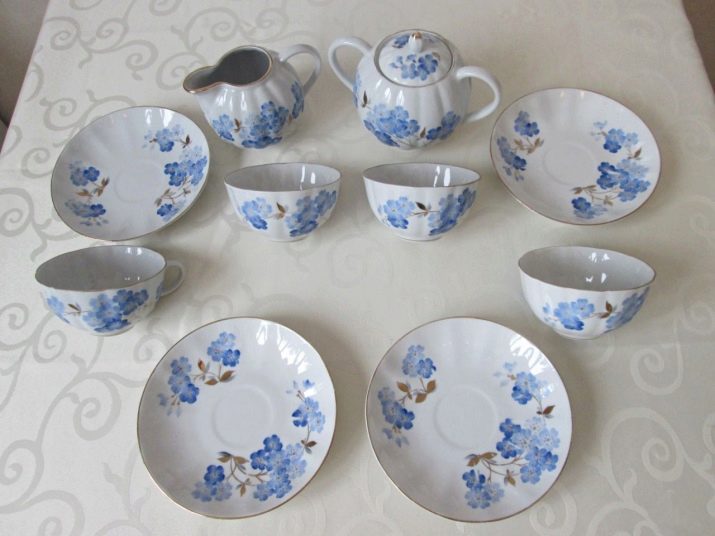
At the same time, another was created - a "tulip" shape with small bright blue flowers designed by L. I. Lebedinskaya. Consisting of: teapot, milk jug, cups and saucers. There is also a turnip-shaped set by Bespalov-Mikhalev - a pot-bellied teapot and cups with blue buds on a white field. All sets are united by a three-color range of patterns - blue-black-gold.
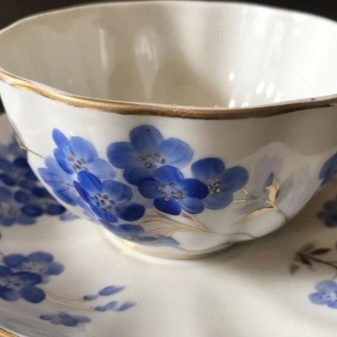
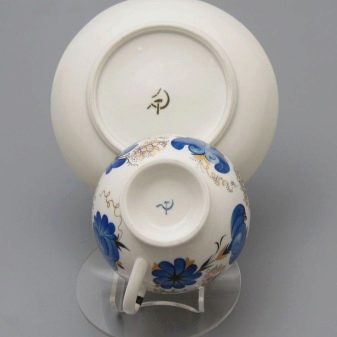
"Golden autumn"
The set was released in the 70s. XX century. In addition to tea pairs, a teapot and a sugar bowl, it includes a milk jug, dessert plates, a flower vase, and a pie dish. The main design element is autumn leaves. Luster dyes give the design a special metallic sheen. The shape of the cups is "tulip".
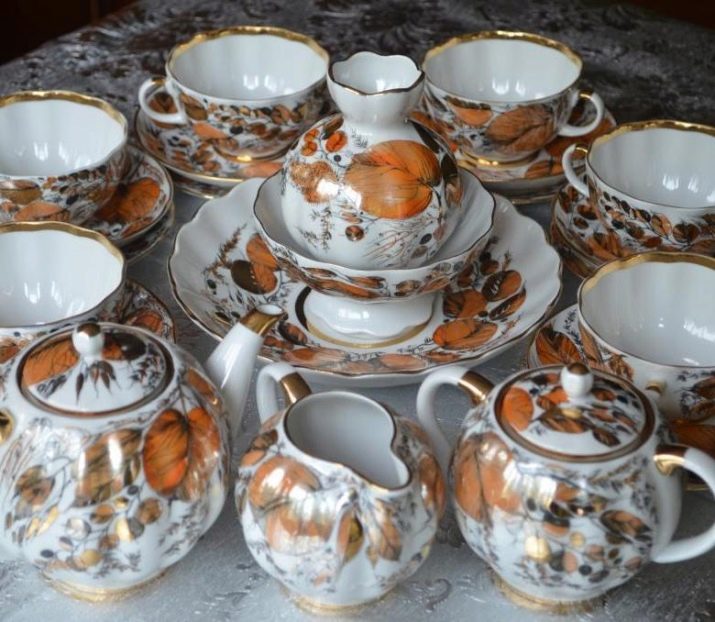
"Generous Autumn"
The autumn gilding of the leaves is complemented by bright orange fruits, bringing the ornament closer to the folk Khokhloma style. The author is A. N. Semenova. Type of cups - "lily of the valley". The composition is identical to the previous set.
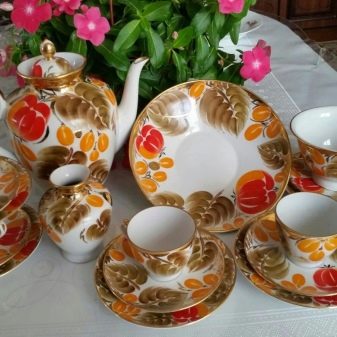
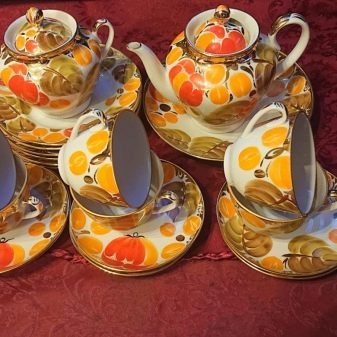
"Golden Garden"
A coffee set with the image of blue birds framed by golden foliage, there is a floral gold rim around the rim of the cups in the shape of a "tulip".
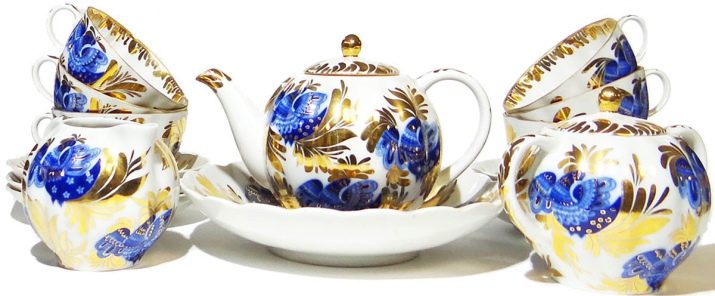
"Northern"
On dessert plates and cups, there is a drawing in red and black colors, stylized as the ornaments of the northern peoples of the USSR. The saucers are completely scarlet, on the lid of the caddy there is a figurine in the form of a miniature teapot with gilding.

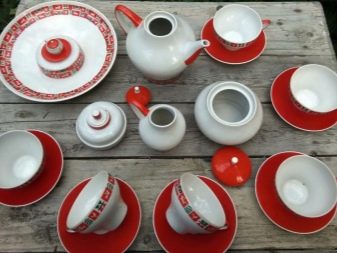
"Winter evening"
The coffee set is a striking example of blue porcelain. Dark cobalt pattern with gold painting on top, gold-plated edging. Discontinued in the USSR. Author - Gorodetsky V.M.
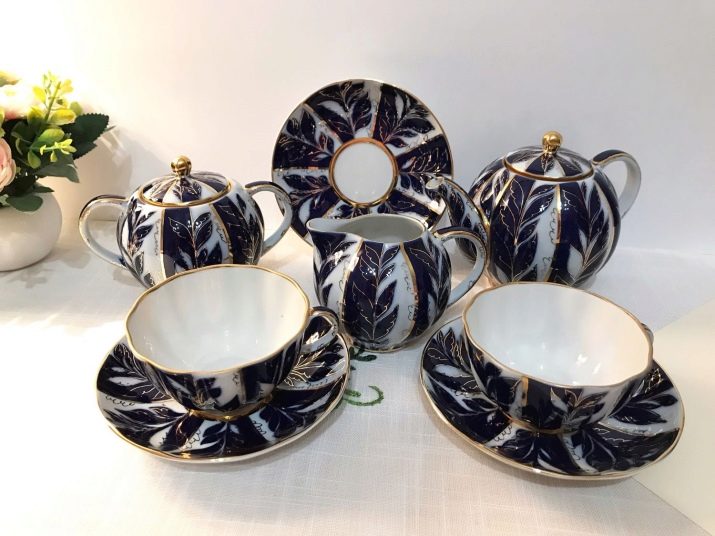
"The Rose"
In the 60-70s. several tea and coffee sets were produced. With lilac and pink flowers, with gilded edging and mother-of-pearl glaze. Each has a unique design.

"Bells"
This highly artistic work - corrugated porcelain, hand-painted, gold edging on the edge... The set included 2 teapots - a large and a small one, a sugar bowl, a milk jug, tea pairs and plates for dessert.

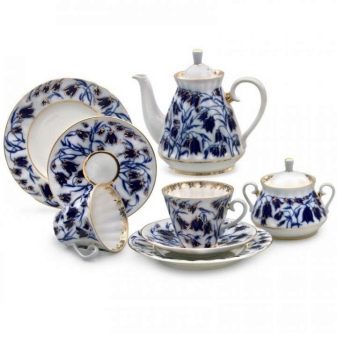
"Rowan" and "Chokeberry"
The latter is crafted in the traditional tulip shape and includes standard tea making facilities. Purple berries with colorful leaves are applied to the white surface. The "Rowan" version is made in the shape of a "lily of the valley" with a pattern in the form of orange berries and rusty rowan leaves.

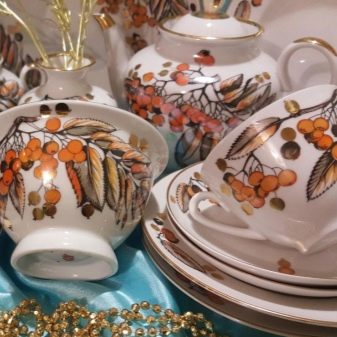
The set, in addition to standard items, includes dessert plates.
"Fruits"
Blue-green set with grapes, plums and pears framed by leaves and gold hand-painted. In addition to the standard composition, there is a fruit bowl and a candy bowl.
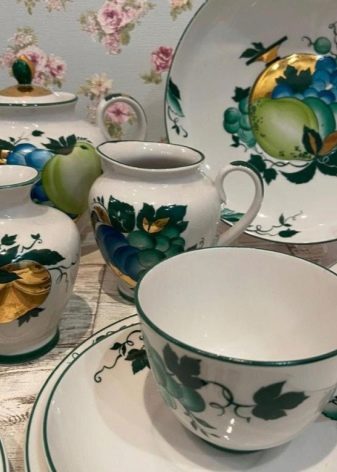
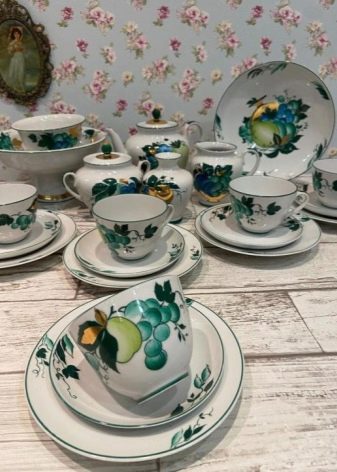
Rare sets produced by LFZ are sold at antique auctions at a fairly high price. For example, the exclusive issue "Industrial Motive" was estimated by an expert at about 70 thousand dollars. Of course, mass-produced dishes are not so highly prized, but among collectors there is a great demand for military-series plates and vases of the mid-20th century.
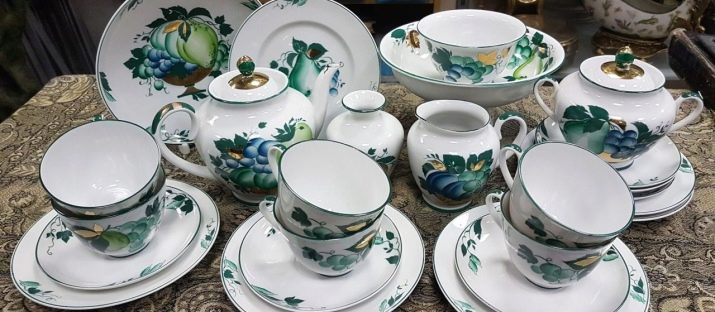
Overview of modern kits
In 2005, LFZ returned the name - "Imperial Porcelain Factory" (IFZ). Combining previous experience and new technologies, labor of talented craftsmen, designers and artists, the plant produces modern and exclusive series.
"Golden daisies"
Created in 1970, the production of tea and coffee appliances was launched. Then it was taken out of production. Since 2012, it has been released in an updated form. Authors - sculptor Serafima Yakovleva, artist Larisa Grigorieva. Items can also be purchased individually.
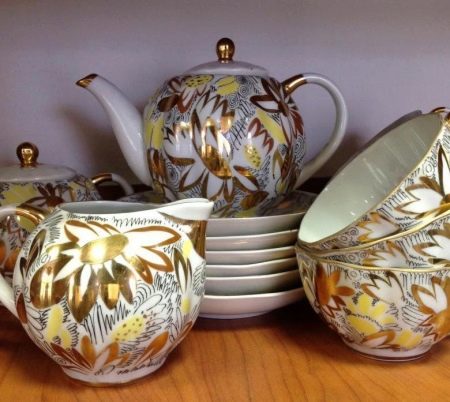
"Pink flowers"
Variations on the theme of flowers are very popular in decoration. The collection is made in the best classical traditions. A graceful look, curved handles, gilded ornament create an exquisite composition for the most solemn occasion.
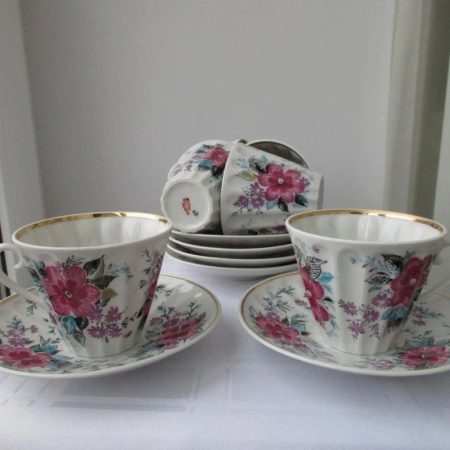
"Landscape frieze"
The tea set for 6 persons is made of hand-cast thin-walled bone china. The author of the drawing, Alexei Vorobyevsky, created a fantastic landscape using floral and architectural ornaments.
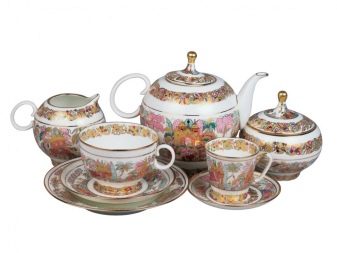

The contours of the teapot and sugar bowl resemble onions on the temples of ancient Russian cities. Each item is hand-painted.
"Bindweed"
The tea set for one person is made of traditional hard porcelain and includes three elements: a pair of tea and a plate for dessert. Blue flowers are gilded on top.
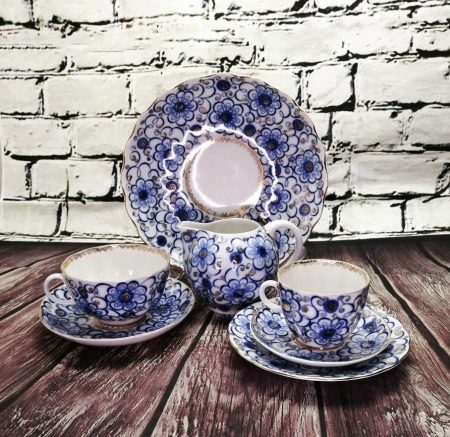
"Thin twigs"
The tea set for 6 persons has an unusual "wave" shape: narrow at the bottom and widening at the top. Created by E. Krimmer. White bone china, overglaze painting, gilded layering. On the top or bottom edge, small dark flowers are depicted on thin branches with black and gilded leaves. The author of the picture is I. S. Olevskaya.
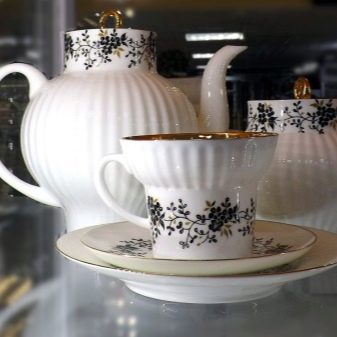

"Gold"
The table service consists of 24 items. Restored in 2008 after a museum model from the Hermitage collection, which was created at the beginning of the 19th century for the wife of Nicholas I, Empress Alexandra Feodorovna.
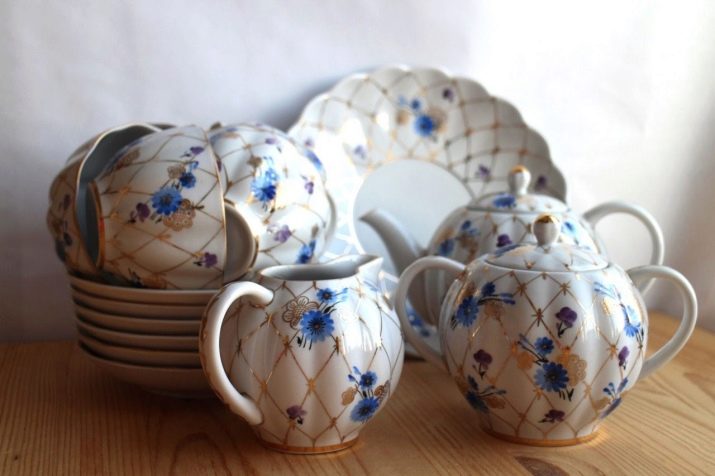
The painting contains blue and green shades, floral and geometric patterns. Covered with gilding and the finest engraving.
"Northern capital"
White coffee tableware for two persons with overglaze design - engraving. The sophisticated classic look is complemented by the finest application of images of famous views of St. Petersburg. Author - N. L. Petrova
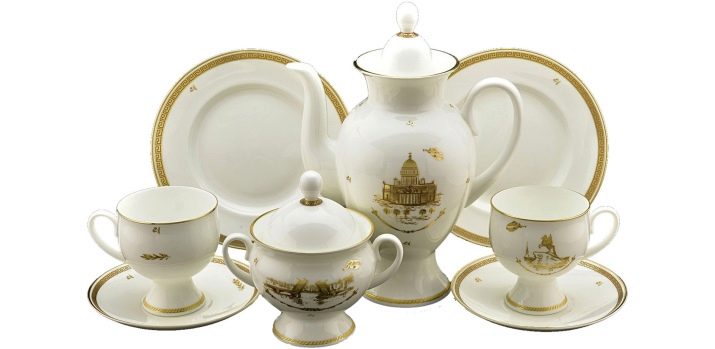
"Berries"
Created in 2016, this is a variation on the 1866 service, made for the future Emperor Alexander III and his bride Maria Feodorovna. The main pattern is an interweaving of blueberry leaves and berries. Violet and light green frames create a juicy composition. Items from the collection can be purchased separately... Designed by N. L. Petrova.
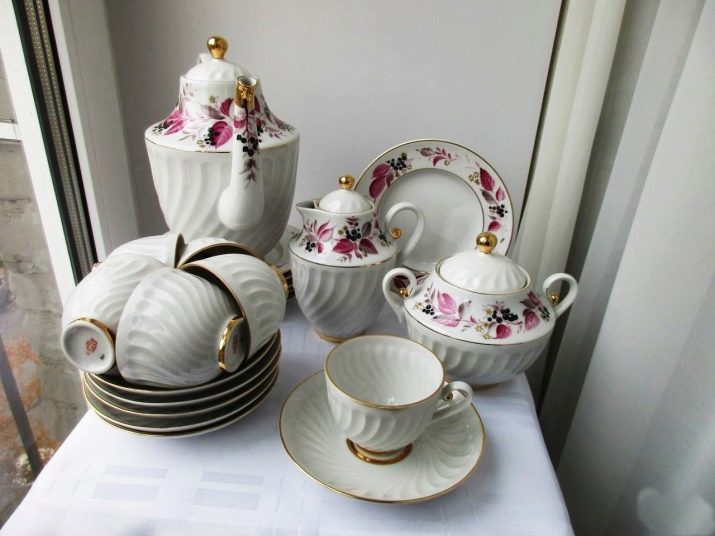
"Zamoskvorechye"
Table, tea and coffee varieties of the service with gilded Alexandria form, developed by French designers. The author of the floral ornament is Shulyak G.D.
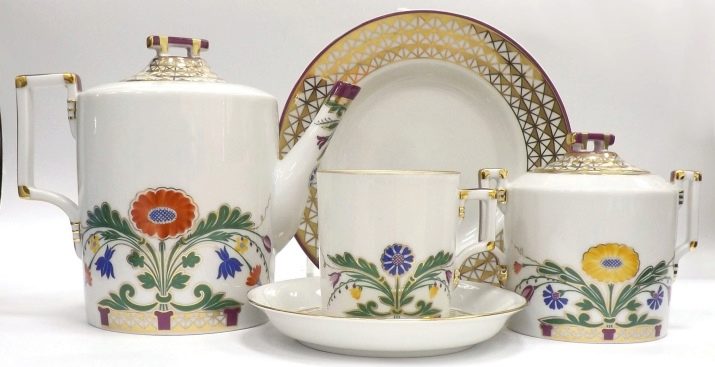
Polychrome painting, geometric and floral ornaments in Old Russian style, hand-painted.
"Swan Lake"
A set of three elements in the collection "Russian Ballet".Each one has an image of swan feathers, weaving of pearl threads. Bright beads surround the airy pattern. The central place is occupied by medallions depicting ballerinas, swans, a lake and a castle. The trim is gilded by hand.









